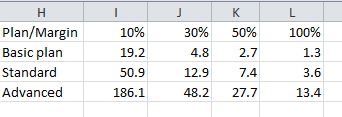We all want to get the most out of our business.
So a proposal was given to me by one of my clients about they making an eCommerce website and that they wanted to do it on the cheap, what they wanted are they looking at to make it work. It is a really hard question to answer as you do not know where to start so I decided to look at a commonly used one Shopify.
To make it work you need to go past the Breakeven point which is the spot where the total revenue equals total costs and expenses. Here there is no profit or loss, you "break-even". It is the most commonly used measure to give a feel of just how much is required to make the project viable.
I then went looking at the relevant plans for a Small to medium-size business (SMB) for Shopify. No reason I picked this one, other then it is commonly used although in truth I am not that keen on it at all. I think there are better solutions for money, for a small site eCommerce site look at WooCommerce.
They have three basic plans for SMB and the one you pick would depend on just how much you hope to move online. The problem here as well is that these plans are very limited and if you require anything more then just these plans there are many additional costs but as the proposal is here, they want nothing more then to do it on the cheap so no additional extras. Note this I do not recommend as some of these so-called additional extras, I think are required.
Now I am going to assume that all the templates and setups, they will do themselves and select the free ones. A professional with a lot of experience usually charge about $4,000 for Shopify and gives you a professional site. In my experience, the person who does it himself on his first attempt has something that looks like a first attempt but as in this proposal, we will say these costs are zero.
Now the next problem is I need the margins, so I decided to make a range of margins to give you an idea and you can select where you fit on the scale. I used
10% mainly as I have clients that sell products at these prices.
30% which is often fairly standard
50% which would be a gift item
100% often people in professional services eg accountants, car mechanic etc consider this all profit
Now I went through the plans taking these items and looked at it
Now there is GST to consider here on the account charges, Shopify is a bit confusing here on this but for this analysis, I will just add it in
I included only local Australian credit card rates, as its only a first-level approximation.
I picked the smallest plan, it cost about USD 29. They also have a payment fee of 1.75% + 30 cents (as Shopify costs are listed in US dollars it is 30 cents USD) per transaction.
Today 1 United States Dollar equals 1.44 Australian Dollar. I will assume here no conversion costs and bank fees etc which is not true.
So a 30% item say with a $40 price which I think is a fair typical price for many of my clients, you would need to sell at least 4.8 items as that gives you revenue of about $190.13 then if you take off
GST $17.28
Cost of goods $120.99
Payment fee of $3.66
Transaction fee $2.26
Shopify fees $45.94
You have zero the breakeven point. So you need to sell at least one item a week. This is not a big ask and we have clients that are doing much more than that.
Now if we do the same analysis for a range of products margins assuming a unit sale of $40, and I have written a quick spreadsheet to automatically calculate these figures on a range of products, so you can see where you are on the scale. This is the result

If you want a copy of the spreadsheet let me know.
These are absolute minimums as it assumes no returns, no extra costs, none of your or your staffs time, no hidden costs that always appear, it also does not include their optional extras like your domain name, themes, joining their marketing campaigns that you would like to leverage to get customers, apps, Email Marketing software and training courses.
These figures are simply designed for you as a first-level approximation.
If you want to know more, please let us know.


